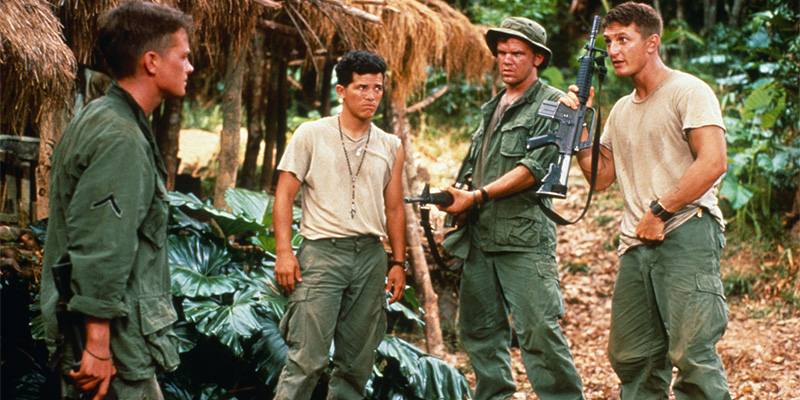Student Essay
g
“Jesus, we’re supposed to be here to help these people!”
The individual’s failure to uphold moral standards against the brutalization of war.
An analysis of Casualties of War by Marlene Wagner
Student at the University of Vienna
In the abundance of Vietnam war movies of the 1980s, coming out shortly after soon-to-be cult classics like Platoon (1986) and Full Metal Jacket (1987), one movie tended (and still tends) to be overlooked, despite receiving many positive reviews: the 1989 war drama Casualties of War by director Brian De Palma, starring Michael J. Fox and Sean Penn in the leading roles. De Palma had already acquired renown with many suspense films, like the critically acclaimed horror thriller Carrie (1976), gangster film Scarface (1983) and crime drama The Untouchables (1987), often causing controversies with displaying scenes of graphic violence on screen.
Seeing that De Palma mostly kept to the thriller genre, it might have seemed untypical of him to enter unfamiliar territory by taking up a war drama, which could be seen as a more sensitive matter, especially since it was based on a real incident that happened in Vietnam during the war in 1966 and was brought to the light by journalist Daniel Lang in 1969. Lang’s article for The New Yorker described the so-called “Incident on Hill 192” that involved the kidnapping, rape and murder of a young Vietnamese woman by a group of four army soldiers that were subsequently brought to trial by their fifth comrade who refused to take part in the crime. The article and later book by Daniel Lang served as the main source for playwright David Rabe’s script for Casualties of War.
The movie focuses on young Private Eriksson, who has been in Vietnam only three weeks and is still a rookie – his comrades soon nickname him “Cherry” due to his inexperience as a battlefield “virgin”. Eriksson is played by Michael J. Fox, who had just gained fame through his family and teen movies like Back to the Future and Teen Wolf (both 1985). He too seemed like an unusual casting choice for a soldier because of his rather boyish look and hitherto mostly comic acting. To my mind, however, this doesn’t make him unfit for the role of a young soldier at all, on the contrary – not all military men were muscular, hardened and steeled grown-ups, many were inexperienced youths who were not at all ready for what was coming at them. So if Michael J. Fox didn’t look like he was ‘right to be a soldier’ (1) or like he ‘belonged’ in a war, then this was because no one really could be looking or feeling that way. Many soldiers who went to Vietnam (and died there) were adolescent men who had been mere schoolboys before the war and weren’t fit to go to battle. If at all, Fox’s boy-next-door kind of look helped to make his character even more authentic and believable, especially since his Pte. Eriksson is a rather naïve and idealistic young man.
The movie starts out with a preview of Eriksson’s life after the war, when he gets haunted by his war trauma while on a tramway back in America. He sees a young Asian woman who reminds him of a Vietnamese victim and thus he recalls his experience as a soldier in a dream/flashback that makes up the greatest part of the movie. This short first sequence serves as a framework plot for telling Eriksson’s story and for binding him to a social world, namely the American civilization, and is taken up again at the very end of the film. Then we go back to Vietnam, in medias res, right in the middle of the action. It is night, dark and confusing, explosions all around, but no enemy soldiers to be seen. This theme of the invisible or unknowable soldier is found throughout the movie (as we will find out later, the real enemy in the central conflict of the story is not the Vietcong), but it was also a real problem in the Vietnam war – the Vietcong forces were fighting from hiding, forcing civilians to help them and not wearing uniform, which made it hard for US troops to identify the Vietcong and the civilian population. In this sequence, the movie spectator sees the enemy before the soldiers do, when the camera goes down and underground where we see the Vietcong tunnel system, and Pte. Eriksson being stuck in there, halfway in. Enter Sergeant Meserve, played by a phenomenally vigorous Sean Penn, who saves Eriksson’s life at the last moment from an approaching Vietcong soldier. Sgt. Meserve is shown to be a very competent, loyal and courageous soldier, but also the kind of guy who shouts and curses while shooting, aggressive and high on adrenaline. Eriksson tries to emulate his sergeant, but the cursing doesn’t really suit him.
Back in the daylight, spirits are high and the squad is joking around while passing through a Vietnamese village. Eriksson is characterised as an outgoing but also too trustful person through his friendly interaction with the Vietnamese civilians, while Meserve is shown as a more hardened person who doesn’t trust any of the “gooks” (2). The scene is peaceful and light with the main characters getting to know each other, until all of a sudden all hell breaks loose and Meserve’s best bud Brownie is severely injured. Suddenly the light fades and the sunny scene gets gloomy and sad, as a visibly shaken Meserve watches Brownie taken away by a helicopter.
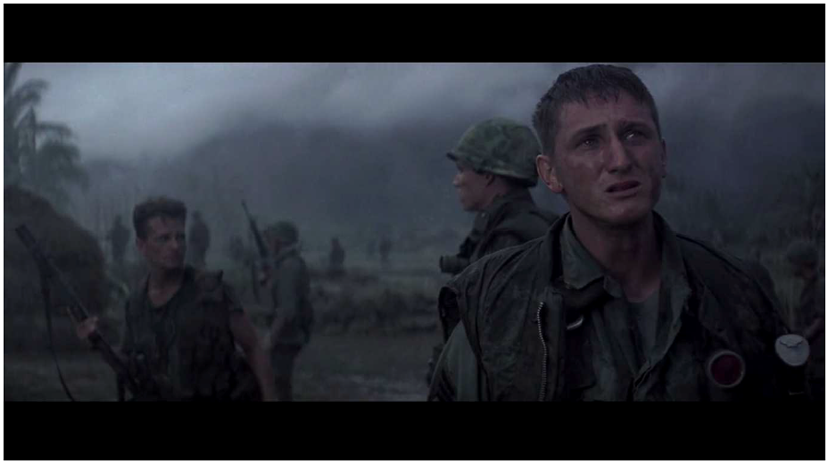
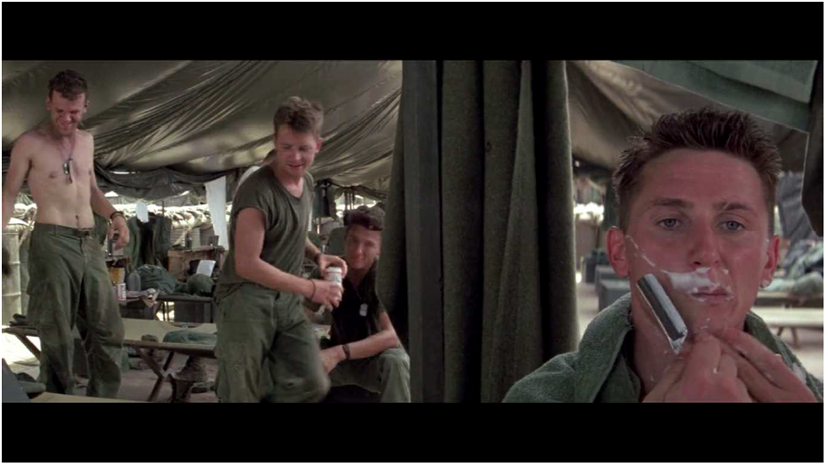
In the next scene, we are at Basecamp Wolf (as we are told by an inter-title and an establishing extreme long shot), where Meserve tells his squad that Brownie has died. His spatial position in relation to the group is the same as before, he is in the foreground on the right half of the shot, turned away from the group in the back. This time, however, his facial expression is the complete opposite from before: hard, blank, not showing any emotions. His friend Brownie’s death is a major turning point for his character, proving Brownie’s words from earlier in the movie true:
“Yeah, the Nam’s a trip. First thirty days you don’t know shit, the last thirty days you don’t give a shit. I mean, you care, but it’s just kinda humpbacked und crooked, you know? Like the cherry – his lot’ll end up wasted ‘cause he don’t know nothing, you and me lot’ll end up in peril because we don’t care about nothing.” (3)
Meserve had responded to this with, “I care, Brownie” back then, but now, he doesn’t anymore. He has already reached his last thirty days, he’s “short”, meaning he can leave Vietnam soon, and before Brownie’s death, it seemed as if he might make it back home safe and sound (physically and mentally), even as a war hero with honours, but now he has lost sight of his impending return. When the group doesn’t get permission to visit a brothel at night, Meserve’s empty façade breaks again and anger arises: As he sees it, after all they’ve been through, they should be entitled to a little distraction and comfort. It seems as though in war, sexuality – in the form of intercourse with prostitutes – is the only means for the men to vent their emotions, to let off steam, figuratively speaking, and probably to reassure themselves of their masculinity. When they are denied that, Eriksson pretends to care only out of loyalty, to fit in with the others, but doesn’t really look bothered. Meserve however shows how deeply he has already internalised the concept of the Vietcong as the enemy, when guessing (probably right) that “the fucking Cong is in the town tonight, is why it’s off limits. Charlie’s in the whorehouse” (4), and subsequently coming up with a plan for some kind of compensation and pay-back: He tells the others that they are going to take a girl from a nearby village to accompany them on their reconnaissance patrol for the next few days. Using a Steadicam shot, we see the search through the sleeping village in a point-of-view long take that makes the spectator feel complicit in the crime: Because of the camera perspective, we are forced to see through Meserve’s eyes, although we feel more prone to identifying with Eriksson, who is horrified by the action. This sequence shot, accompanied with Ennio Morricone’s haunting soundtrack and the otherwise ominous quiet until the screaming of the kidnapped girl starts, effectuates a masterful build-up of suspense, bearing also De Palma’s auteur mark in the camera work of cinematographer Stephen H. Burum. The following long shots of the nature through which the squad passes, e.g. in the red sky of dawn, are of an overwhelming beauty that stands in stark contrast to the harrowing scene we have just witnessed, bringing with them an unsettling ambivalence that recalls Terrence Malick’s The Thin Red Line in its contrasting juxtaposition of nature, life and beauty with the horrors of war, destruction and death.
The abduction of the young Vietnamese woman marks the first plot point and the end of the first act of the movie that served to get us to know the main characters as well as their motives and their surrounding. The second act now describes the journey of the five soldiers’ patrol with their kidnap victim through the jungle, leading up to the inevitable confrontation of our hero Eriksson and his antagonist Meserve, who through his charisma easily wins the support of the rest of the group. Right in the middle of the film, after about 50 minutes, the conflict comes to its central point in a mid-act climax. Let me take a closer look at this crucial scene.
The sequence starts out (at minute 47) with a high angle shot looking down at a quiet and peaceful scene, with only sounds of nature and the calm talking of the soldiers as they sit in front of a hootch, a shack that they found in the jungle. Just as the camera is lowered, Meserve is walking over to Eriksson sitting in the foreground, with his brutal comrade Clark staying a few feet in the background, watching them. Now Meserve is standing over Eriksson, rifle in hand, the camera looking up to him – the more powerful position. But then he sits down next to Eriksson, and with him the camera tilts, so that now they are both literally on the same level, making small talk. It’s obvious that Meserve is playing the “we’re all friends” card now, although Eriksson had already alienated him before when questioning their deed. He is a very charismatic leader and not used to people opposing him, so he thinks he might talk Eriksson around; he even apologises for jumping on Eriksson earlier, blaming it on the whole situation, their arduous mission, the imminent danger of life from the Vietcong, emphasising their need to be able to count on each other.
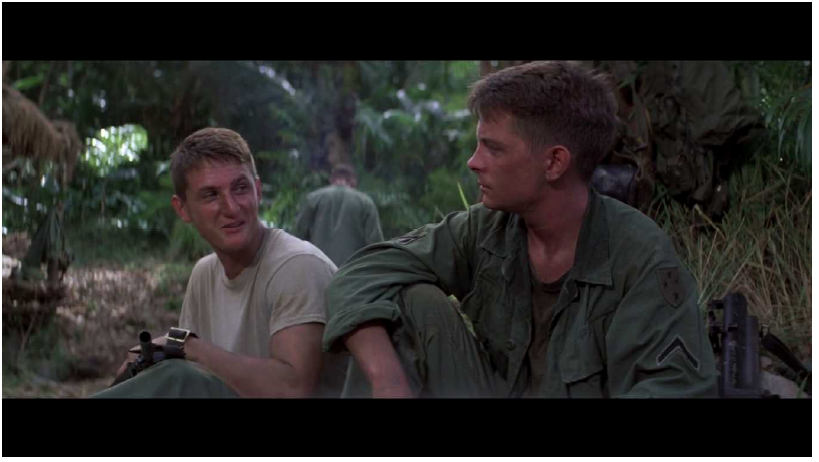
This idea is quite reminiscent of the common war film trope of the supposed brotherhood, cooperation and male bonding between the young soldiers, which is a central theme in the World War II movies before Vietnam as well as in the new Hollywood war films of the 1990s and early 2000s (like Saving Private Ryan, We Were Soldiers, Black Hawk Down or the TV mini-series fittingly called Band of Brothers). The realist combat films from the era of Casualties of War, the late 1980s, rather showed a focus on father/son relationships between the naïve soldiers and their mentor-like superior, like in Platoon, for example. (5) In Casualties of War, however, there is no father-figure around during the entire second act, so Eriksson has nobody to turn to with his problem. Meserve who saved his life at the very beginning, is now threatening it, despite his competence as a soldier he cannot serve as a role model anymore. The brotherly bond between the squad that had started to form in the exposition had also dissolved when Eriksson started opposing the consensus of the group. So all he has got left now is himself – not a great premise for survival out in the field. This failure of cooperation is typical for the Vietnam war films of the 1980s, which “argue that working together is impossible […]. Instead the films focus on the conflict that arises between the men, and it is that conflict that must be resolved through the course of the film”, as Philippa Gates states in her paper “Fighting the Good Fight”. (6)
Meanwhile at our mid-act climactic scene, Meserve is moving the conversation over to the girl in the hooch. Although he’s still talking friendly, he’s definitely in control of the situation. But when his brotherly act doesn’t work because Eriksson sticks to his own moral code rather than to his sergeant’s rules, the conflict soon becomes visible again, even in the spatial positioning: Not sitting next to each other anymore, are they now standing opposite each other, with the frightened girl in the middle, separating them visually, just as she is the matter dividing them ideologically.
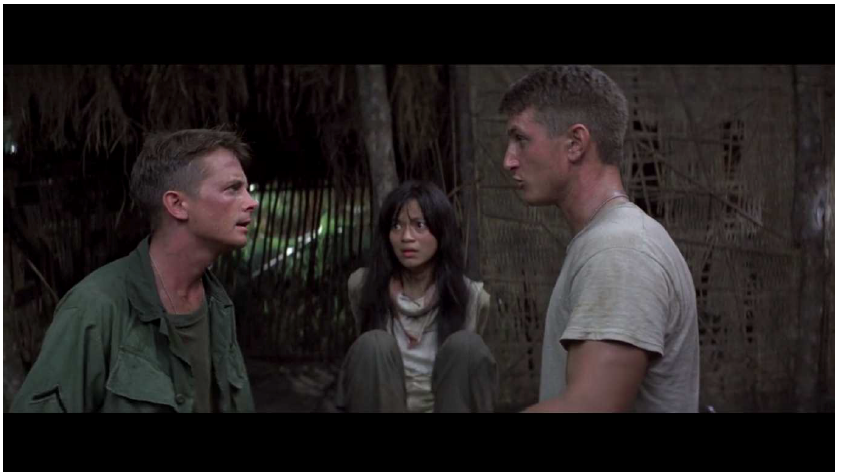
Now as the confrontation gets more aggressive, the group dynamic becomes visible as the squad assembles behind Meserve, leaving Eriksson alone on the opposite side, the camera changing to a shot – counter-shot montage of medium close-ups as the conflict heats up and becomes more emotional. The war of words becomes even more hostile when Meserve starts to get closer physically while threatening Eriksson’s life verbally and metaphorically with the raised rifle barrel between them.
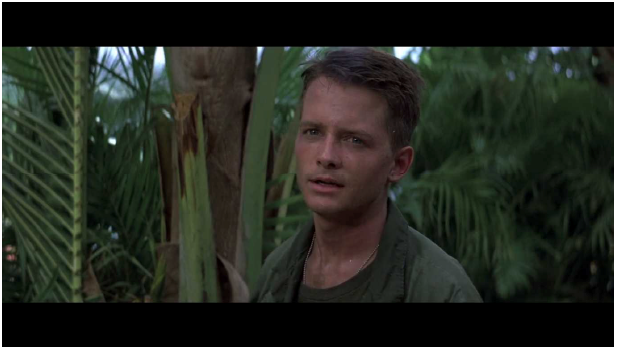
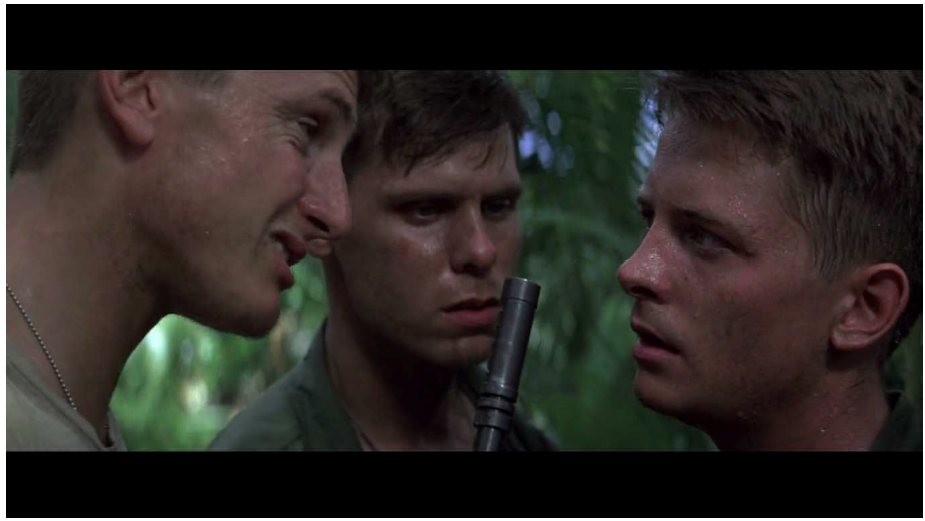
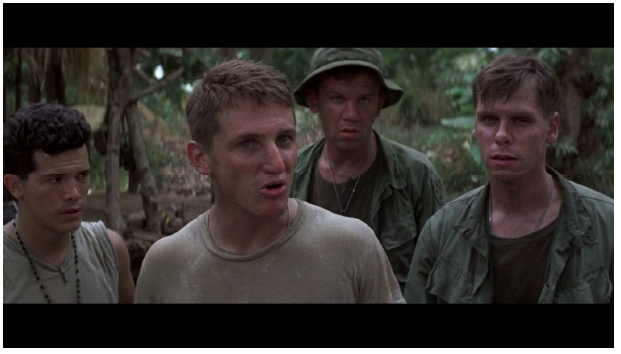
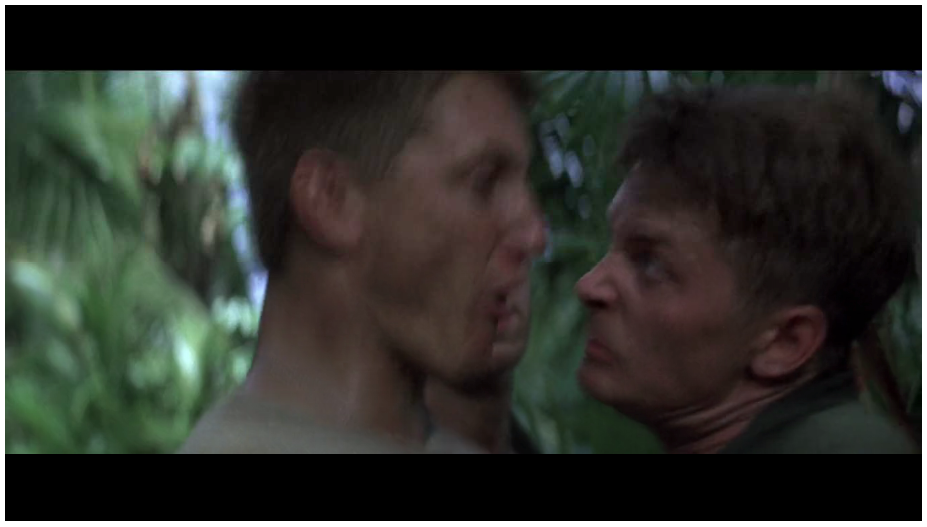
When Meserve threatens to rape him too and touches Eriksson physically, the situation escalates with Eriksson drawing his weapon. But this doesn’t impress his opponent. In a world where everybody carries a rifle, he knows that his charismatic and manipulative words are the more powerful weapon. His supporters draw their weapons too, but Meserve throws his own rifle over to Eriksson. He knows he doesn’t need it because he controls the group just by sheer force of personality. By changing to a long shot now, the group dynamic becomes evident, with Clark and Hatcher sticking close to Meserve, weapons in hands, while Diaz is standing in the middle, looking unsure and weak, but not making a stand. Eriksson, choosing individual thinking over loyalty to his comrades, can’t stand a chance on his own. Group thinking and peer pressure therefore prove to be essential themes of this story.
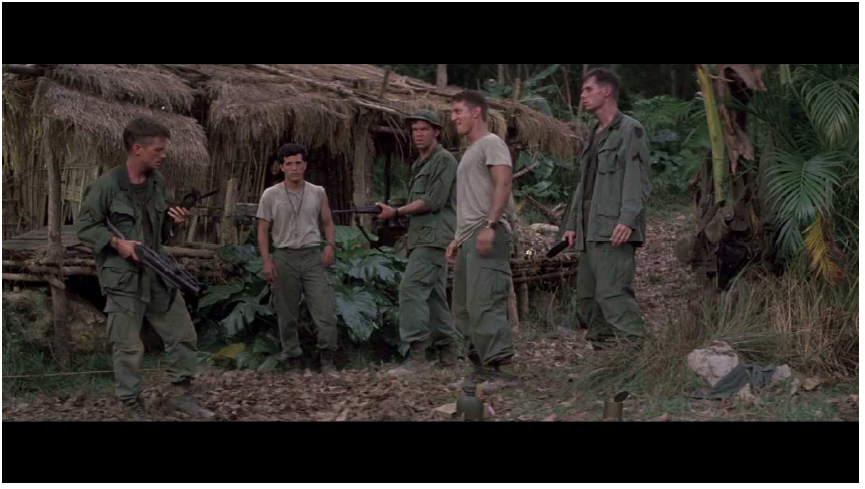
At this climax of the confrontation, Meserve goes over to the Vietnamese girl and rapes her, knowing that Eriksson is powerless against the group. As he walks over to the hut, the soundtrack starts to play, marking the emotionality of the scene, while Meserve declares that his rifle isn’t a weapon. “This is”, he says, grabbing his crotch. His penis, his sexuality, his masculinity – “this is for fighting”, while his rifle is “for fun”. (7) To my mind, this declaration is an essential point of the movie, because it brings up the topic of the crisis of masculinity through the war. Seeing his male sexuality as a weapon to exercise power, brings to light the patriarchal ideology of male dominance behind the training of the soldiers and the war as a whole. It can also be seen as a critique of the instrumentalisation of the soldiers for military and political purposes, because if a body is seen as a weapon, this means that the human being is seen as a tool instead of an individual, whose worth is measured in effectiveness instead of character. Thus a person like Meserve can be honoured as a war hero because of his effectiveness in the battle, while ignoring his lack of ethics and humanity.
Later on, after the second plot point, namely the brutal murder of the abused woman that marks the ending of the second act, the squad returns to the camp, where the climax of Eriksson’s story comes in form of his comrades’ failed attempt to kill him, after which he confronts Meserve one final time before the plot comes to a denouement as Eriksson manages to bring the men to trial. This proves to be a hard fight for our hero, since the potential father figures at the camp, his lieutenant and his captain, seem to care more about the army reputation than about justice and morality. The exceptional circumstances of the war serve as an excuse for them to justify the horrible crimes of the squad, while the movie tries to make the exact opposite statement in its promo tagline: “Even in war… murder is murder.” (8)
If we now revisit Philippa Gates’ paper on the different types of war movies, we can find some similarities as well as differences between Casualties of War and other war films of the late 1980s that she calls the realist combat films. Like those, Casualties of War focuses on the subjective experience of the grunt on the ground instead of the bigger political picture, and can certainly be seen as a morality play with an idealistic youth as the hero. (9) On the other hand, there is rarely any combat in this movie, no long big battle scenes, and the main war is fought out with words between the main characters. There doesn’t seem to be a focus on realism in the style of the movie either – the camera perspective changes and is sometimes filming from the antagonist’s point of view, the pan down in the first battle scene to the Vietcong underground tunnel supports the aesthetic style and suspense of the sequence, but not the realist feeling of being there. No shaky hand-held camera, no main focus on tight close-ups to create a feeling of immediacy, rather stylistic choices on the cinematography instead. What tries to give the story some claim to authenticity is the caption at the beginning, stating that the movie is “based on a real incident” (which to me sounds a lot more accurate than the claim to be a “true story” by films like Platoon or Hotel Rwanda). The problem, for me, is that this might convey the idea that “Incident on Hill 192” was an isolated case that sadly happened this one time, when we now know that rape and murder of civilians were actually daily fare in Vietnam, encouraged by rewarding high body counts with promotions or vacations. But even Eriksson denies that in the movie, when saying that “this is not the army”. What he doesn’t realize is, that is the army, and his story is not the only one of its kind. Still, we rarely find any Vietnam war movies that address those gender issues or tell the story of the women in war – even Casualties of War doesn’t tell the girl’s story, but Eriksson’s – he is a victim, a casualty of war too, seeing that his traumatic experience still haunts him as a veteran.
Then again, when we return to the subject of masculinity, Philippa Gates is right to state that the war movies of the 1980s were “concerned with a crisis of masculinity incited by the American failure in Vietnam, and this crisis was worked through along the lines of gender—masculinity was honoured and femininity reviled. Feminised men were either killed off as the more manly men survived, or they too became masculinised.” (10) This point is shown, but also turned around and criticised in Casualties of War. Indeed, Eriksson is the idealistic youth and a rather feminized character, who has to harden to stand up to the hyper-masculine Meserve and to survive their personal war. He does become more masculinised too, he’s not the cherry anymore in the end (he hits Clark with a shovel, plus he doesn’t even really help some nervous new kid). But he still sticks to his intellect and doesn’t resort to violence. This reinforces the idea of American civilization as the ideal, because there are rules that follow a moral code and are enforced by a judiciary system, while in the wild jungle of Vietnam men become savage, barbaric animals. Not unlike Coppola’s cult classic Apocalyse Now, Casualties of War plays with those binary opposites, like culture vs. nature, naivety vs. disillusionment, brotherhood vs. individuality, following orders vs. free will, and so on.
Furthermore, one could argue that this movie, even though it does not really review the political level, it does in fact display the American failure in Vietnam by Eriksson failing to help the Vietnamese woman. Even though he brings the culprits to court, he isn’t able to stop them from committing the crime. All he can do is say, “I’m sorry” – to the girl and her family whom he failed to help. This story in the end has no heroes and no winners. It is the story of failing even when trying to do the right thing – a conclusion which can be directly applied to America’s involvement in Vietnam, as well.
Notes
- See also: http://www.hitfix.com/motion-captured/movie-rehab-fox-vs-penn-in-brian-de-palmas-overlookedcasualties-of-war
- “[A] racist, derogatory army slang term for an Asian person, also a colloquial expression meaning “dirt” or “mud”. See also: http://www2.iath.virginia.edu/sixties/HTML_docs/Resources/Glossary/Sixties_Term_Gloss_D_J.html#Letter’G‘
- Casualties of War, Minute 11.
- Casualties of War, Min. 25:37
- Compare to Gates: Fighting the good fight, p. 304.
- Gates: Fighting the good fight, pp. 303-304.
- Casualties of War, Min. 51-52
- Taken from the IMDb page for Casualties of War http://www.imdb.com/title/tt0097027/taglines?ref_=tt_stry_tg
- Gates: Fighting the good fight, p. 301
- Gates: Fighting the good fight, p. 301
Filmography
- Casualties of War, R: Brian De Palma, USA 1989
- Apocalypse Now, R: Francis Ford Coppola, USA 1979
- Band of Brothers, R: Tom Hanks (et al.), UK/USA 2001
- Black Hawk Down, R: Ridley Scott, USA/UK 2001
- Full Metal Jacket, R: Stanley Kubrick, UK/USA 1987
- Platoon, R: Oliver Stone, UK/USA 1986
- Saving Private Ryan, R: Steven Spielberg, USA 1998
- The Thin Red Line, R: Terrence Malick, USA 1998
- We Were Soldiers, R: Randall Wallace, USA/Germany 2002
Bibliography
Philippa Gates (2005). “Fighting the Good Fight: The Real and the Moral in the Contemporary Hollywood Combat Film,” in: Quarterly Review of Film and Video, 22:4, pp. 297-310, (DOI:10.1080/10509200590475788).
Winfried Fluck (2008). “The “Imperfect Past: Vietnam According to the Movies,” in: The Merits of Memory. Concepts, Contexts, Debates, pp. 353-385.
John Hellmann (1982). “Vietnam and the Hollywood Genre Film: Inversions of American Mythology in the Deer Hunter and Apocalypse Now,” in: American Quarterly,Vol. 34, No. 4, pp. 418-439.
Additional Links
- http://www.motherjones.com/politics/2013/03/rape-wartime-vietnam
- http://www.motherjones.com/politics/2013/01/how-did-gates-hell-open-vietnam-jonathan-schell
- http://www.phoenixnewtimes.com/news/there-is-yet-more-to-casualties-of-war-6445590
- http://www.nytimes.com/movie/review?res=950DE6D6113DF93BA2575BC0A96F948260
- http://www.hitfix.com/motion-captured/movie-rehab-fox-vs-penn-in-brian-de-palmas-overlookedcasualties-of-war
- https://www.youtube.com/watch?v=jPXAxNr8Cno
- http://www.heise.de/tp/artikel/22/22805/1.html:
- http://www.rogerebert.com/reviews/casualties-of-war-1989
- http://www.imdb.com/title/tt0097027/?ref_=tttg_tg_tt

